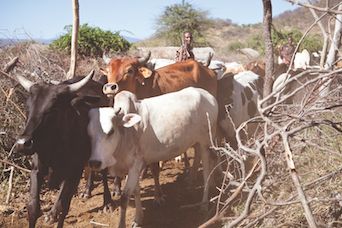Increasing Detection of Emerging Zoonotic Pathogens
Important components of global disease surveillance include rapid local response, timely communication, and organized infrastructure.

According to the CDC, more than half of all known human pathogens originated in animals.1 Also, zoonotic pathogens account for all but one of the category A pathogens classified by the National Institute of Allergy and Infectious Diseases; these are the pathogens that represent the highest risk to national security and public health.2 Furthermore, experts estimate that only a small fraction of existing pathogens have been identified, leaving significant potential for global outbreaks of uncharacterized diseases.3
Two veterinarians from the University of California (UC), Davis One Health Institute—Brian Bird, DVM, ScM, PhD, and Jonna Mazet, BS, DVM, MPVM, PhD— recently provided a detailed overview of the complex dynamics influencing the global emergence of novel pathogens.4 They cited recent disease outbreaks, including the 2013 Ebola virus epidemic, to highlight barriers that can inhibit the flow of information at local, regional, and international levels. The authors also described the implementation of 2 international disease surveillance programs led by the UC Davis One Health Institute: PREDICT and the Tanzania Virus-Sharing Project.
THE HISTORY OF ZOONOTIC DISEASE
Zoonotic disease transmission relies on a variety of biological, sociological, and behavioral factors.5 As domestication of wild animals occurred throughout history, the potential for zoonotic pathogen transmission increased. Domestic animal production in areas of high wildlife density also led to the spillover of particular diseases, such as the tickborne illness Crimean-Congo hemorrhagic fever virus, which transferred from ostriches to domestic ruminants and humans. Finally, hunting and consumption of bushmeat directly transmitted zoonotic pathogens, including monkeypox and Ebola virus, from wildlife to humans. Within the past 100 years, global movement of animal species for various purposes, including the food and pet trades, has dispersed a wide variety of pathogens at an unprecedented rate.6
Pathogen emergence can refer to the first detection of a previously unknown pathogen (eg, severe acute respiratory syndrome [SARS]), movement of a pathogen into a new geographic area (eg, West Nile virus to the United States), or transmission into a new host species (eg, H5N1 from birds to humans).7 Emergence also can signify the discovery of a novel disease presentation, such as the association of Zika virus with neurologic effects in newborn humans during the 2015 and 2016 epidemic in North, Central, and South America.8
COMMUNICATION: CRUCIAL TO A ONE HEALTH APPROACH
The One Health Initiative recognizes that human, animal, and environmental health disciplines are interconnected and that collaboration among individuals from all disciplines, including medical specialists, laboratory scientists, behaviorists, epidemiologists, and statisticians, is important for successful management of global health issues.
Important components of a One Health response include the following:
- Integrated responses at local, national, and international levels
- Availability of properly trained medical personnel
- Equipped facilities
- Proper use of diagnostic tools
Prompt Local Response
The 2013 Ebola virus outbreak in Guinea, Liberia, and Sierra Leone was more than 60 times larger than any previous outbreak since the discovery of the virus in 1976.9,10 Response to the outbreak, which ultimately claimed more than 11,000 human lives, was complicated by a combination of unique factors. Among these, several international health workers attempting to provide aid were killed by the local community out of fear and mistrust of government outsiders, ultimately impeding early efforts to minimize spread of the epidemic.11
According to Drs. Bird and Mazet, incidents such as these illustrate the importance of a strong, efficient local effort during the early phases of an outbreak. Local health care workers tend to be most familiar with common pathogens in the area; therefore, properly trained individuals can recognize novel or exotic diseases and facilitate a rapid response to outbreaks. The authors also emphasized that personnel who are familiar with societal and religious customs are often respected in their communities and so can play a critical role in minimizing fear and encouraging local civilians to enlist medical aid.
The PREDICT Project
The authors described the PREDICT project, an integrated program for detecting new and unknown pathogens with pandemic potential, namely coronaviruses, paramyxoviruses, influenza viruses, and filoviruses. The PREDICT consortium is funded by the US Agency for International Development’s Emerging Pandemic Threats Program and led by the UC Davis One Health Institute. PREDICT currently trains scientific staff in more than 30 countries and focuses surveillance toward humans and animals in disease emergence hot spots at “high-risk human—animal interfaces.” Diagnostic procedures are directed as far to the local level as possible, whereas national and global systems are used to evaluate and minimize the risk of an epidemic. Diagnostic tools include broadly reactive polymerase chain reaction (PCR) assays to identify pathogens to the family or genus level, and these are followed by high-throughput sequencing to provide specific diagnoses.
The ultimate goal of the PREDICT project, the authors stated, is to shift the official disease response from a postoutbreak reaction to a proactive, preventive program. With these principles in place, PREDICT detected more than 800 novel viruses in more than 20 countries during the program’s first 5 years.
INFRASTRUCTURE: FACILITIES, EQUIPMENT, AND DIAGNOSTIC TOOLS
In addition to trained personnel, organized facilities and equipment are essential components of a coordinated response to emerging zoonotic threats. Although locally driven systems may be more expensive than centralized systems, a higher level of organization at the local level allows for more rapid detection of pathogens. Also, preventive disease surveillance programs typically cost a fraction of the expense associated with managing a pandemic outbreak. The authors provided the example of the 2001 SARS pandemic, which cost $40 to $50 billion USD12; in contrast, the entire One World-One Health workforce in 49 at-risk countries was managed for $852 million USD in 2008.13
Rapid Pathogen Detection: Selecting Appropriate Diagnostics
After the 2001 SARS pandemic, 196 World Health Organization member countries adopted international health regulations that require countries to report human or animal disease outbreaks with potential public health impacts within 24 hours of detection.14
Rapid pathogen detection relies on the selection of appropriate diagnostic tools. A variety of identification and characterization methods are typically used during disease surveillance and outbreak response phases, including virus isolation, bacterial culture, histology, immunohistochemistry, electron microscopy, fluorescent antibody assays, and PCR.
The authors emphasized that methods should be selected carefully to reflect the timing of the outbreak. The acute phase of infection for many diseases lasts only a few days, and pathogen shedding typically decreases as active infection resolves. Therefore, diagnostic tools identifying the host’s antibody response (eg, enzyme-linked immunosorbent assay), rather than nucleic acid of the pathogen itself, are more appropriate during later phases of infection. Antibody assays are also appropriate for detecting previous exposure in an asymptomatic reservoir or carrier.
Molecular diagnostic techniques, such as PCR and qualitative PCR, have become standard diagnostic tools during disease outbreaks due to their high sensitivity and specificity rates. While the development of these tools has increased the overall rate of disease detection, many assays are so specific that they miss closely related pathogens. This issue has been addressed through the development of next-generation sequencing, high-throughput sequencing, and the use of degenerate primers to detect multiple pathogens at once. The authors emphasized that molecular diagnostics, while more technologically advanced than classic diagnostic tools, should always be interpreted in conjunction with patient history and physical examination findings.
A relatively new diagnostic tool, known as the rapid diagnostic test (RDT), is a lateral-flow assay that detects the presence or absence of pathogen antibodies or antigens. RDTs are appropriate for field use as they have low technologic requirements, are thermostable, and do not require electricity. Although they generally have lower sensitivity and specificity values than alternative molecular and antibody assays, RDTs are particularly useful in remote or resource-poor locations and were utilized during the 2013 Ebola virus outbreak.15
Drs. Bird and Mazet also described a relatively novel diagnostic technique involving multivalent antibody-detection assays created using bacteriophage-display technology.16 Such assays are capable of detecting antibodies from a patient’s entire history of exposure, rather than targeting 1 specific pathogen group. “Although still highly experimental,” the authors said, “this technological advance may revolutionize pathogen detection in a manner similar to what PCR technology did in the 1980s and 1990s.”
THE TANZANIA VIRUS-SHARING PROJECT
The Healthy Animals and Livelihood Improvement program is an international collaborative disease surveillance effort between the UC Davis One Health Institute and Sokoine University of Agriculture in Morogoro, Tanzania. Focusing on 4 regional sites with high levels of human—wildlife interaction, the program performs disease surveillance in humans and local wildlife. Blood, oral, and fecal samples from patients with nonmalarial febrile illness, as well as nonhuman primates and bats, are screened using reverse transcriptase-PCR for coronaviruses, filoviruses, influenza viruses, paramyxoviruses, and flaviviruses. Patients also complete a survey to evaluate risk of pathogen exposure from wildlife and livestock. Suspect-positive cases are further screened at UC Davis, and positive cases are sent to specialty diagnostic centers internationally for complete isolation and characterization. This program incorporates disease surveillance with risk analysis from the survey responses to provide the most complete epidemiologic perspective possible.
SUMMARY
Technological advances have significantly improved the detection rate of emerging pathogens; however, the authors emphasized that even the most sophisticated tools cannot supplant the value of a vigilant local response. The maximum benefit of a disease outbreak response occurs when initial cases are recognized early and the potential for pathogen spread is minimized.
References
- Zoonotic diseases. CDC website. cdc.gov/onehealth/basics/zoonotic-diseases.html. Updated June 14, 2018. Accessed September 11, 2018.
- NIAID emerging infectious diseases/pathogens. National Institute of Allergy and Infectious Diseases website. www.niaid.nih.gov/research/emerging-infectious-diseases-pathogens. Reviewed July 26, 2018. Accessed September 12, 2018.
- Anthony SJ, Epstein JH, Murray KA, et al. A strategy to estimate unknown viral diversity in mammals. Mbio. 2013;4(5):e00598-e00613. doi: 10.1128/mBio.00598-13.
- Bird BH, Mazet JAK. Detection of emerging zoonotic pathogens: an integrated One Health approach. Annu Rev Anim Biosci. 2018;6:121-139. doi: 10.1146/annurev-animal-030117-014628.
- Wolfe ND, Dunavan CP, Diamond J. Origins of major human infectious diseases. Nature. 2007;447(7142):279-283.
- Jones KE, Patel NG, Levy MA, et al. Global trends in emerging infectious diseases. Nature. 2008;451(7181):990-993. doi: 10.1038/nature06536.
- Taylor LH, Latham SM, Woolhouse ME. Risk factors for human disease emergence. Philos Trans R Soc Lond B Biol Sci. 2001;356(1411):983-989. doi: 10.1098/rstb.2001.0888.
- Martines RB, Bhatnagar J, Keating MK, et al. Notes from the field: evidence of Zika virus infection in brain and placental tissues from two congenitally infected newborns and two fetal losses—Brazil, 2015. MMWR Morb Mortal Wkly Rep. 2016;65(6):159-160. doi: 10.15585/mmwr.mm6506e1.
- World Health Organization. Ebola haemorrhagic fever in Zaire, 1976. Bull World Health Organ. 1978;56(2):271-293.
- World Health Organization. Ebola haemorrhagic fever in Sudan, 1976. report of a WHO/International Study Team. Bull World Health Organ. 1978;56(2):247-270.
- Shultz JM, Cooper JL, Baingana F, et al. The role of fear-related behaviors in the 2013-2016 West Africa Ebola virus disease outbreak. Curr Psychiatry Rep. 2016;18(11):104. doi: 10.1007/s11920-016-0741-y.
- World Bank. People, Pathogens and Our Planet, Volume 2: The Economics of One Health. Washington, DC: World Bank; 2012.
- World Bank. People, Pathogens and Our Planet, Volume 1: Towards a One Health Approach for Controlling Zoonotic Diseases. Washington, DC: World Bank; 2010.
- World Health Organization. International Health Regulations (2005). 3rd ed. Geneva, Switzerland: World Health Organization; 2016.
- Phan JC, Pettitt J, George JS, et al. Lateral flow immunoassays for Ebola virus disease detection in Liberia. J Infect Dis. 2016;214(suppl 3):S222-S228. doi: 10.1093/infdis/jiw251.
- Courbet A, Renard E, Molina F. Bringing next-generation diagnostics to the clinic through synthetic biology. EMBO Mol Med. 2016;8(9):987-991. doi: 10.15252/emmm.201606541.
